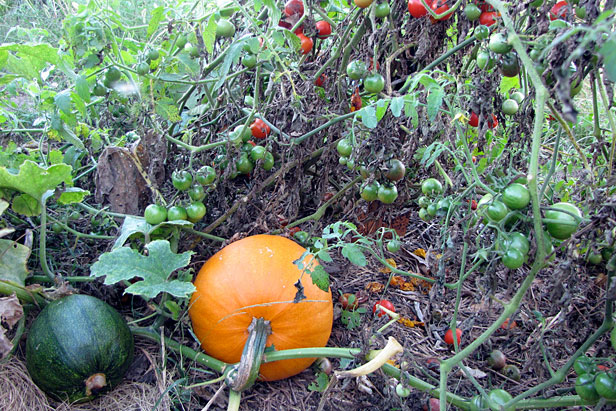 Security gourds: These squash have somehow ended up hanging out with the tomatoes, 15 feet from where I planted them. Photo: Steph Larsen
Security gourds: These squash have somehow ended up hanging out with the tomatoes, 15 feet from where I planted them. Photo: Steph Larsen
Living things have a habit of not doing what you expect them to. It’s the nature of life, to adapt as best you can to the circumstances presented. But sometimes plants and animals can go places you aren’t intending, and the consequences can be minor … or catastrophic.
Take my garden, for example. This spring, I armed myself with a new notebook full of empty graph paper and the best intentions to record everything from weather conditions to which crops flourished and flopped. I researched how much space each plant needed and paced out the grids in my garden so that nothing would be crowded.
And then it rained, and both the notebook and my intentions drowned in the downpour.
As I look at this first garden at the farm, I have two distinct impressions. One is that the weeds staged a revolutionary overthrow against any kind of order I tried to bring. I’ve had to embrace the fact that I simply don’t have time for “immaculate gardening” where the only plants within my 50-by-50-foot square are the ones I planted. It was all I could do to keep up with planting and harvesting, and weeding didn’t make it to the top of the list as often as it rained. I am not a tidy person by nature, so I shouldn’t be surprised.
The rows of tomatoes and the bed of strawberries fared better than the beans and beets due to copious use of straw mulch. Next year, I will be much more liberal with my mulch use. I’d rather spend $4 on a bale of straw than hours whacking weeds with a corn knife. We were hesitant to use black plastic as a weed barrier, but perhaps next year we’ll give it a try. Readers, how do you feel about the plastic sheeting? Are there better, non-petroleum-based options that really work?
The garden still yielded more vegetables than we could eat, so I really can’t complain.
My second impression of the garden is that there are squash vines absolutely everywhere. I have pumpkins growing in the tomato cages and Delicatas weighing down the eggplants. I have to be careful where I step to avoid a Blue Hubbard or a butternut in places I wasn’t expecting them. It was a good year for winter squash. Next year, they may very well get their own section of the garden to spread out at will.
Examples of the futility of keeping life contained abound. Remote islands in the Pacific are teeming with life; farmed salmon easily escape their pens into the wild. And genetically engineered (GE) corn, that promiscuous plant whose pollen can travel for miles, has contaminated the genetics of conventionally bred and organic corn around the world.
Not everyone wants to eat transgenic plants, as evidenced by the public outcry that led to McDonald’s pulling GE potatoes from its menu in 2000 or India banning GE eggplant earlier this year. Some evidence suggests that eating genetically engineered plants has adverse consequences for animals. More independent risk-assessment research is definitely needed in this area.
But back to nature. The difficulty is that once GE plants — and perhaps soon we’ll be talking about GE animals, too, once the AquAdvantage salmon gets approved — are produced on a commercial scale, in the open field or sea, it’s very difficult, if not impossible, to control their spread. Take, for example, GE alfalfa. As a crop, alfalfa is pollinated by bees who fly upwards of a mile from their hive, spreading pollen all along the way. In 2006, agents from Colorado State University Extension tested feral alfalfa within 2 miles of GE alfalfa fields and found the modified gene in 83 percent of their samples.
Given Monsanto’s habit of winning lawsuits against farmers whose fields get contaminated and the ease with which contamination occurs, it seems awfully cavalier to refuse to follow some kind of precautionary principle. And indeed, the Supreme Court’s June decision on alfalfa seems to support this. For the first time, gene “flow” like the kind seen in the CSU study or feared by organic farmers and rangers can be categorized as “environmental harm.”
If you’re still reading, perhaps you’re thinking, “OK, so what can I do about this?” There are lots of options, from avoiding buying GE foods (hard to do, I know, but some good guides exist) to pushing the USDA for labeling standards. Grow your own food, call your members of Congress, run for county commissioner. Engage a friend, or six, in a hard conversation about what they eat. Chain yourself to Monsanto’s corporate headquarters. (Maybe not that last one.) The possibilities are limited only by your creativity, and shouldn’t humans try to be at least as wily as the plants we try to control?




